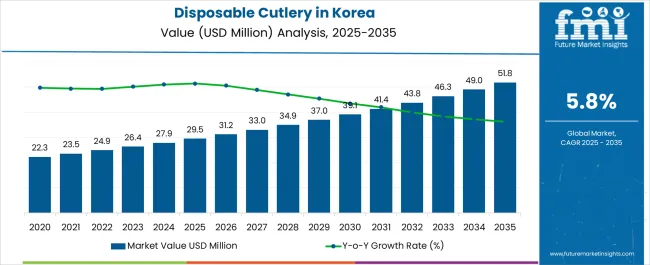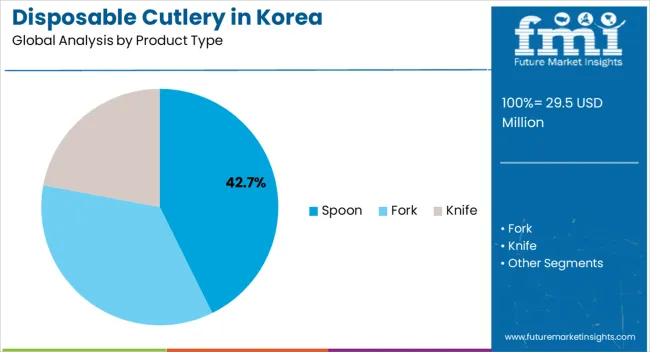The Demand and Trend Analysis of Disposable Cutlery in Korea is estimated to be valued at USD 29.5 million in 2025 and is projected to reach USD 51.8 million by 2035, registering a compound annual growth rate (CAGR) of 5.8% over the forecast period.

| Metric | Value |
|---|---|
| Demand and Trend Analysis of Disposable Cutlery in Korea Estimated Value in (2025 E) | USD 29.5 million |
| Demand and Trend Analysis of Disposable Cutlery in Korea Forecast Value in (2035 F) | USD 51.8 million |
| Forecast CAGR (2025 to 2035) | 5.8% |
The disposable cutlery market in Korea is witnessing rising demand driven by urban lifestyle shifts, growth in food delivery services, and increasing reliance on convenience-driven dining solutions. The current scenario is defined by strong adoption across quick service restaurants, cafes, and catering businesses, supported by expanding e-commerce channels and ready-to-eat food consumption. Regulatory focus on sustainable and recyclable materials is shaping production strategies, compelling manufacturers to innovate with biodegradable and eco-friendly options.
Future outlook remains favorable as consumer preference aligns with both convenience and environmental responsibility. Growth rationale is underpinned by rising disposable incomes, high urban density encouraging takeaway culture, and continued technological advancements in production that enhance cost efficiency and product durability.
Distribution channels are strengthening through modern retail, online platforms, and institutional buyers, ensuring broader accessibility Over the forecast horizon, a combination of consumer-driven demand and regulatory pressure is expected to drive both volume growth and structural transformation toward sustainable disposable cutlery solutions.

The spoon segment, holding 42.70% of the product type category, has emerged as the most dominant due to its versatile usage across beverages, desserts, and main course accompaniments. Market leadership is supported by consistent demand from quick-service outlets, delivery platforms, and institutional catering services.
Production efficiencies and cost competitiveness have reinforced widespread adoption, while customization in size and design has strengthened brand and consumer appeal. Despite increasing availability of substitutes such as reusable cutlery, the convenience and hygiene benefits of disposable spoons have secured a stable demand base.
With rising consumer awareness around eco-friendly products, biodegradable and compostable spoon variants are being increasingly integrated into supply chains, ensuring long-term market presence and reinforcing the segment’s share.

The thermoforming process, representing 38.40% of the fabrication process category, has maintained dominance due to its ability to produce lightweight, durable, and cost-effective cutlery at scale. Its widespread application has been supported by material efficiency, faster cycle times, and reduced waste generation, making it a preferred choice for high-volume manufacturers.
The process has further benefited from adaptability in using biodegradable plastics and plant-based polymers, aligning with sustainability requirements in Korea’s regulatory landscape. The segment’s competitive edge is being sustained by investments in automation and precision tooling, which enhance consistency and reduce operational costs.
Future growth is expected to be driven by increasing demand for sustainable alternatives and government-backed initiatives encouraging eco-friendly production practices, positioning thermoforming as a central driver in the disposable cutlery market.

The wrapped cutlery segment, accounting for 46.10% of the cutlery type category, has led the market by offering enhanced hygiene and convenience, particularly favored in delivery and takeaway services. Market share has been reinforced by growing consumer preference for pre-packed, contamination-free dining solutions, especially in post-pandemic food consumption patterns.
Adoption has been accelerated by quick service restaurants and catering services that prioritize safety and operational efficiency. The segment’s appeal is further strengthened by packaging innovations, enabling integration of biodegradable wraps and compact multi-piece sets.
Cost efficiency in bulk supply and strong adoption within institutional and healthcare sectors have supported sustained demand Over the forecast period, rising consumer expectations for hygiene, combined with regulatory support for sustainable packaging, are expected to reinforce the segment’s leadership and expand its penetration across both retail and institutional channels.
South Gyeongsang, a region with a diverse economic landscape, including manufacturing and agriculture, could have a dynamic disposable cutlery industry. Given the province significant industrial presence, it is plausible that there are manufacturing facilities producing disposable cutlery to cater to both local and national markets.
The industry in South Gyeongsang might be influenced by global trends, with a potential focus on sustainability given the increasing importance of eco-friendly materials. The province strategic location and infrastructure could also play a role in the distribution and supply chain aspects of the disposable cutlery industry.
North Jeolla, known for its agricultural and manufacturing sectors, may also be in the disposable cutlery industry. The agricultural emphasis in the province could lead to an increased demand for disposable cutlery, especially in food service and catering. The industry in North Jeolla might be influenced by regional preferences, potentially catering to local culinary traditions and practices.
Additionally, given the province role as an agricultural hub, there could be a focus on sustainable and eco-friendly materials in disposable cutlery production, aligning with global trends. Local businesses may also play a role in shaping the industry landscape.
The table below highlights how spoon and food service will lead the product type and end-use in 2025.
| Category | Industrial Share in 2025 |
|---|---|
| Spoon | 56.9% |
| Food Service | 59.6% |
In the rapidly evolving landscape of the disposable cutlery industry, 2025 is poised to witness a prominent surge in the dominance of specific product types and end-use categories. Forecasts indicate that spoons will emerge as a frontrunner, commanding a substantial industrial share of 56.9%.
This notable uptick underscores disposable spoons enduring popularity and widespread utility in various applications, from domestic settings to broader commercial and industrial contexts.
The food service sector is anticipated to play a pivotal role in steering the trajectory of the disposable cutlery industry, capturing a significant share of 59.6%. This robust representation signifies disposable cutlery integral role in food service, encompassing restaurants, catering services, and diverse culinary establishments.
The heightened demand within the food service category underscores the convenience, efficiency, and hygiene considerations that drive the pervasive use of disposable cutlery in the dynamic landscape of the hospitality and food industry.
| Attribute | Details |
|---|---|
| Estimated Industry Size in 2025 | USD 29.5 million |
| Projected Industry Size in 2035 | USD 51.8 million |
| Anticipated CAGR between 2025 to 2035 | 5.8% CAGR |
| Demand Forecast for the Disposable Cutlery Industry in Korea | 2025 to 2035 |
| Report Coverage | Industry Size, Industry Trends, Analysis of key factors influencing the Disposable Cutlery Industry in Korea, Insights on Global Players and their Industry Strategy in Korea, Ecosystem Analysis of Local and Regional Korea Providers |
| Key Provinces Analyzed | South Gyeongsang, North Jeolla, South Jeolla, Jeju |
| Key Companies Profiled | Hyunjin Co. Ltd; Chang Sung Band Co. Ltd; Anhui Jialong Knives Manufacturing Co. Ltd; Anchor Packaging; Apollo Funds; Biopak; D&W Fine Pack; Dart Container Corporation; Hotpack Global; Pactiv Evergreen; Gold Plast |
The global demand and trend analysis of disposable cutlery in Korea is estimated to be valued at USD 29.5 million in 2025.
The market size for the demand and trend analysis of disposable cutlery in Korea is projected to reach USD 52.0 million by 2035.
The demand and trend analysis of disposable cutlery in Korea is expected to grow at a 5.8% CAGR between 2025 and 2035.
The key product types in demand and trend analysis of disposable cutlery in Korea are spoon, fork and knife.
In terms of fabrication process, thermoforming segment to command 38.4% share in the demand and trend analysis of disposable cutlery in Korea in 2025.






Full Research Suite comprises of:
Market outlook & trends analysis
Interviews & case studies
Strategic recommendations
Vendor profiles & capabilities analysis
5-year forecasts
8 regions and 60+ country-level data splits
Market segment data splits
12 months of continuous data updates
DELIVERED AS:
PDF EXCEL ONLINE
Demand Signal Repository Solutions Market Size and Share Forecast Outlook 2025 to 2035
Demand Side Management Market Size and Share Forecast Outlook 2025 to 2035
Demand Response Market Analysis - Size, Share, and Forecast Outlook 2025 to 2035
Demand for Industrial Chocolate in EU Size and Share Forecast Outlook 2025 to 2035
Demand for Industrial & Institutional Cleaning Products in EU Size and Share Forecast Outlook 2025 to 2035
Demand for Joint Compound in EU Size and Share Forecast Outlook 2025 to 2035
Demand for Taurine in EU Size and Share Forecast Outlook 2025 to 2035
Demand for Kaolin in India Size and Share Forecast Outlook 2025 to 2035
Demand for DMPA in EU Size and Share Forecast Outlook 2025 to 2035
Demand for 3D Printing Materials in Middle East Size and Share Forecast Outlook 2025 to 2035
Demand for Protein-rich Shelf-stable UHT Oat Drinks in Latin America Size and Share Forecast Outlook 2025 to 2035
Demand for Yeast in EU Size and Share Forecast Outlook 2025 to 2035
Demand for Oat Drink in EU Size and Share Forecast Outlook 2025 to 2035
Demand for Vanillin in EU Size and Share Forecast Outlook 2025 to 2035
Demand for Spirulina Extract in EU Size and Share Forecast Outlook 2025 to 2035
Demand for Pulse Ingredients in EU Size and Share Forecast Outlook 2025 to 2035
Demand for Gypsum in EU Size and Share Forecast Outlook 2025 to 2035
Demand for Barite in EU Size and Share Forecast Outlook 2025 to 2035
Demand for Shrimp in the EU Size and Share Forecast Outlook 2025 to 2035
Demand for Mezcal in EU Size and Share Forecast Outlook 2025 to 2035

Thank you!
You will receive an email from our Business Development Manager. Please be sure to check your SPAM/JUNK folder too.
Chat With
MaRIA